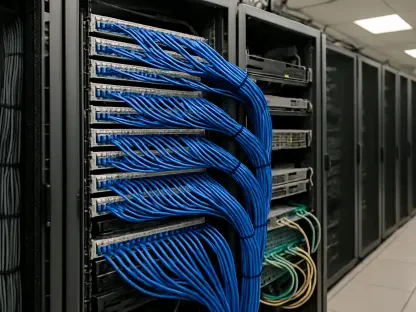In the rapidly transforming landscape of artificial intelligence, where data centers are the beating heart of technological innovation, Astera Labs (NASDAALAB) has emerged as a compelling force in high-speed connectivity solutions. As AI applications demand ever-faster and more reliable infrastructure to handle massive computational workloads, the spotlight is on companies that can deliver seamless, scalable connections. Astera Labs, a semiconductor specialist, has captured significant attention with its robust financial results and strategic positioning in this high-stakes arena. With the AI infrastructure market experiencing unprecedented growth, the question arises whether Astera truly stands out as a leader in connectivity solutions. This article delves into the company’s recent performance, innovative edge, market alignment, and the risks tied to its valuation, offering a comprehensive look at whether it deserves the hype as a key player to monitor in the AI-driven tech ecosystem.
Unleashing Financial Strength in a Booming Sector
Astera Labs has demonstrated remarkable financial prowess, positioning itself as a heavyweight in the AI infrastructure space. In the second quarter of this year, the company reported an extraordinary revenue of $191.9 million, reflecting a staggering 150% increase compared to the same period last year. This leap, coupled with a non-GAAP earnings per share of $0.44 that surpassed analyst expectations, underscores the surging demand for Astera’s offerings amid the AI boom. Products like PCIe 6.0 solutions have become critical for hyperscalers and cloud providers grappling with escalating data needs. Beyond these headline figures, the company’s forward-looking guidance for the third quarter—projecting revenue between $203 and $210 million—signals unwavering confidence in sustained momentum. This financial trajectory not only highlights Astera’s operational success but also its ability to capitalize on the growing reliance on AI-driven technologies across industries, setting a high bar for competitors in the connectivity domain.
Delving deeper into the financial narrative, Astera Labs showcases operational efficiency that bolsters its market standing. A gross margin of 76% and operating income of $75.2 million reflect a business model that balances rapid growth with profitability. Additionally, a healthy cash flow of $135.4 million provides the company with the flexibility to invest in innovation and scale operations. These metrics are particularly significant in a sector where capital-intensive R&D is often necessary to maintain a competitive edge. The strong financial foundation suggests that Astera is not merely riding a temporary wave but is structurally equipped to meet the long-term demands of AI infrastructure. For stakeholders, this stability offers a measure of reassurance, even as broader market dynamics evolve. Yet, while these numbers paint an optimistic picture, they also raise expectations for consistent delivery, a challenge Astera must navigate to solidify its reputation as a leader in this space.
Pioneering Through Partnerships and Technology
Astera Labs isn’t just keeping pace with the AI revolution; it’s actively shaping the future through strategic collaborations and cutting-edge innovations. Key partnerships with industry titans like NVIDIA on NVLink Fusion and AMD on UALink technology have cemented Astera’s role in developing open-ecosystem solutions critical for modern AI architectures. These alliances enable the company to address the complex interoperability needs of advanced data centers. Furthermore, its collaboration with Alchip Technologies to integrate custom ASICs broadens Astera’s market reach, showcasing adaptability in a fast-changing landscape. Products such as the Scorpio Fabric Switches exemplify the company’s focus on high-bandwidth connectivity, a cornerstone for scaling AI systems. This combination of strategic ties and technological advancements positions Astera Labs as a forward-thinking player, capable of influencing industry standards and meeting the nuanced demands of next-generation computing environments.
Beyond partnerships, Astera’s commitment to innovation sets it apart in a crowded field. The company’s emphasis on PCIe 6.0 technology addresses the critical bottleneck of data transfer speeds, a persistent challenge as AI workloads intensify. This focus aligns with the broader industry shift toward rack-scale systems that require robust connectivity to function efficiently. Astera’s ability to anticipate and solve these technical hurdles through its product portfolio demonstrates a proactive approach to market needs. Moreover, the company’s leadership has articulated a vision of building the essential “highways for AI,” a metaphor that captures the foundational role of connectivity in powering artificial intelligence. This strategic clarity, backed by tangible advancements, suggests that Astera is not just reacting to trends but is helping to define the trajectory of AI infrastructure. For industry observers, this raises the stakes on whether Astera can maintain this innovative momentum amid rising competition.
Aligning with Explosive Market Growth
The broader market dynamics provide a fertile ground for Astera Labs to thrive, as the global AI chip market is forecasted to expand at a compound annual growth rate of 30% through 2030. Connectivity solutions, often overshadowed by processors and accelerators, are increasingly recognized as the linchpin of scalable AI systems. Astera’s specialized focus on this niche places it in an enviable position to benefit from the escalating investments in data center infrastructure by major tech players. With products like the Scorpio line projected to account for over 10% of revenue this year, the company is tapping into the urgent need for high-performance interconnects in complex AI setups. This alignment with market trends suggests that Astera could outpace broader industry growth, capitalizing on a segment that is both critical and underappreciated. As AI continues to permeate diverse sectors, Astera’s role in enabling seamless data flow becomes even more pivotal.
Looking at the bigger picture, the surge in AI adoption by hyperscalers and cloud service providers underscores the strategic importance of companies like Astera Labs. The demand for infrastructure capable of supporting massive scale-up architectures is not a fleeting trend but a structural shift in how technology is deployed. Astera’s solutions cater directly to this need, offering the bandwidth and reliability required for next-generation applications, from machine learning to real-time analytics. This market fit is further validated by the company’s growing design wins, which signal trust from major clients in Astera’s ability to deliver. While the AI boom presents vast opportunities, it also intensifies the pressure on Astera to scale production and maintain quality. The trajectory of the market offers a promising backdrop, but success will hinge on the company’s capacity to execute flawlessly in an environment where technological obsolescence is a constant threat.
Navigating Valuation Challenges
Despite its impressive achievements, Astera Labs faces scrutiny over its valuation, which could temper investor enthusiasm. Trading at a price-to-earnings ratio of 471.06, the company’s stock price commands a significant premium compared to sector averages, raising questions about potential overvaluation. Although a 150% year-over-year revenue increase and a 50% monthly stock surge highlight strong market confidence, the flat year-to-date performance hints at underlying volatility. When benchmarked against peers like Broadcom and Credo Technology, Astera’s valuation sits in a contentious middle ground, neither the highest nor the most conservative. This pricing dynamic suggests that while growth prospects are robust, external factors such as economic uncertainties or shifts in investor sentiment could trigger corrections. For those considering Astera as a long-term hold, this valuation puzzle demands a careful assessment of whether the premium is justified by future potential.
Adding to the valuation debate are the inherent risks of short-term market fluctuations that Astera Labs must weather. Post-earnings stock movements, including significant after-hours gains, point to a high degree of speculative interest that can amplify price swings. While the company’s fundamentals—such as a robust gross margin and strong cash reserves—provide a buffer, they don’t fully insulate against broader sector challenges like competitive pressures or geopolitical tensions affecting semiconductor supply chains. Investors must also consider the possibility of overbought conditions in the near term, especially given the rapid stock appreciation in recent months. Balancing these risks against Astera’s undeniable growth narrative requires a nuanced approach, focusing on whether the company can sustain its trajectory amid a landscape where high expectations often collide with harsh market realities. This tension underscores the need for vigilance in evaluating Astera’s investment appeal.
Weighing the Investment Landscape
Astera Labs presents a classic high-risk, high-reward proposition for investors navigating the AI infrastructure wave. On one hand, the company’s financial strength, with a 76% gross margin and substantial cash flow, offers a degree of stability uncommon among high-growth tech firms. Its leadership in PCIe 6.0 and AI interconnect solutions further bolsters a compelling case for long-term value creation. However, the elevated stock valuation introduces a layer of uncertainty, as does the potential for short-term overbought conditions to spark volatility. For those with a horizon of three to five years, Astera’s roadmap and market positioning might justify the current pricing, provided execution remains consistent. Yet, the specter of economic headwinds or intensified competition looms large, reminding stakeholders that even promising ventures carry inherent uncertainties in this fast-paced sector.
To make informed decisions, monitoring specific indicators will be crucial for gauging Astera Labs’ staying power. Key areas to watch include the company’s ability to expand margins further, secure additional design wins with major clients, and adapt to evolving market demands without compromising on innovation. The semiconductor space is notoriously unforgiving, with rapid shifts in technology and customer preferences capable of derailing even the most promising players. Astera’s success in navigating these challenges will determine whether it can maintain its edge in AI connectivity. Additionally, external factors such as tariff policies or supply chain disruptions could impact operational efficiency, making resilience a critical attribute. As the AI infrastructure story unfolds, Astera stands at a crossroads where strategic execution and market adaptability will define its legacy as either a fleeting success or a lasting leader in this transformative field.









